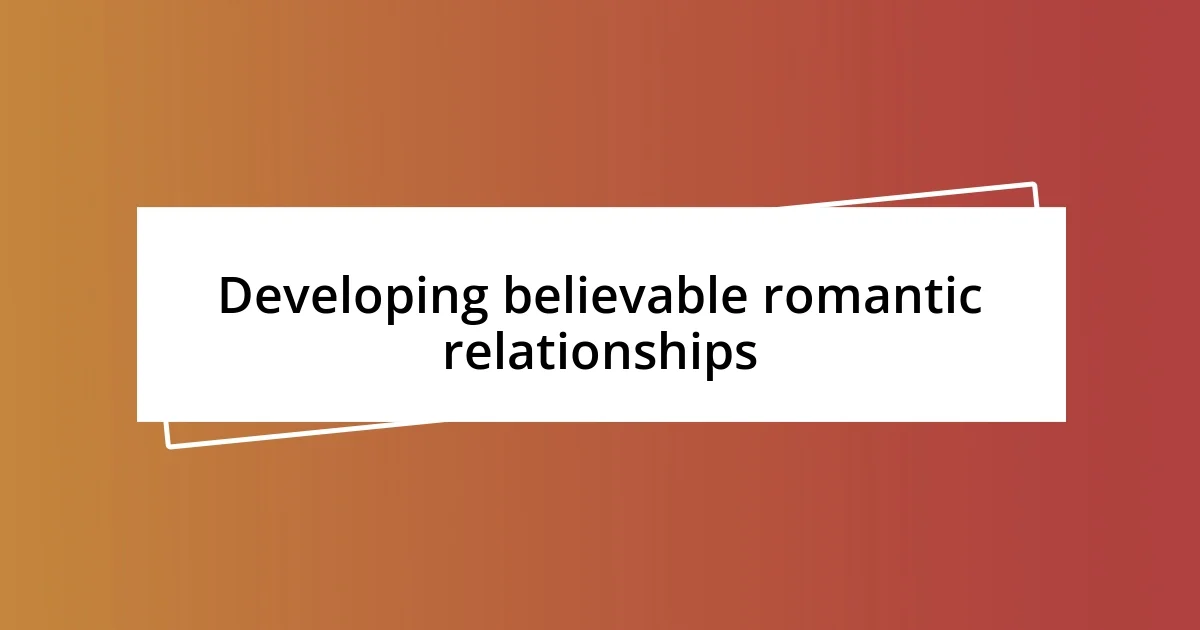Key takeaways:
- Romance serves as a powerful narrative device, reflecting real-life dynamics and adding depth to human relationships in fiction.
- Believable romantic relationships in fiction are built on character depth, a foundation of friendship, and vulnerability, mirroring authentic emotional struggles.
- A well-balanced integration of romance and plot dynamics enhances storytelling, with romance enriching character development and amplifying narrative tension.

Understanding romance in fiction
Romance in fiction serves as a powerful narrative device that explores the complexities of human relationships. I remember digging into a novel where the characters faced insurmountable odds, yet their love propelled them forward. Isn’t it fascinating how romance can act as both a source of conflict and resolution, bringing depth to the story?
What I find particularly intriguing is how romance can mirror real-life dynamics. Sometimes, I catch myself relating to a character who struggles to voice their feelings; it reminds me of times when I’ve hesitated to speak my heart. Have you ever felt that tug between vulnerability and the fear of rejection? That’s the essence of romance—it resonates with our experiences, making those fictional moments feel painfully real.
As I read various genres, I notice that the portrayal of romance takes different shapes. From the whimsical fairy-tale love to the heart-wrenching sacrifices in dystopian settings, each representation tells us something unique about love. I often wonder, how does our own relationship with love change as we explore these diverse narratives? It’s a rich tapestry that invites us to reflect on our views, hopes, and fears regarding love.

Developing believable romantic relationships
When crafting believable romantic relationships, I think it’s crucial to develop characters that are multifaceted and relatable. I recall reading a novel where the protagonist and their partner shared not only chemistry but also flaws and insecurities. Their arguments felt authentic because they stemmed from real issues, mirroring conflicts I’ve seen in my own relationships. Have you ever witnessed a couple where their struggles just highlighted their strengths? That’s how grounded romance should feel.
As I reflect on various portrayals of love, I’ve noticed that the best relationships in fiction often emerge from a foundation of friendship. I remember a story in which the couple began as childhood friends, and their slow transition to romance felt genuine and earned. It reminds me of my own friendships that blossomed unexpectedly—those connections can provide the rich emotional groundwork necessary for believable romance. Doesn’t it resonate when love grows from familiarity and shared experiences?
In my experience, showing vulnerability is a cornerstone of developing believable romantic relationships. I think back to a book where two characters finally opened up about their past traumas, which deepened their bond significantly. It struck a chord with me because I’ve had moments where showing my true self brought me closer to someone. When characters face their fears together, it mirrors the reality many of us encounter in our own relationships. Isn’t that what we yearn for in romance—to see our own emotional struggles reflected in fiction?
| Element of Believable Romance | Example from Fiction |
|---|---|
| Character Depth | Flawed protagonists with relatable issues |
| Friendship Foundation | Romantic relationships building from friendship |
| Vulnerability | Characters sharing past traumas to deepen connections |

Balancing romance and plot dynamics
Balancing romance and plot dynamics requires careful attention. I’ve often found that a well-integrated romantic subplot can elevate the overall narrative without overshadowing the main plot. For instance, in a thrilling fantasy series I once read, the romance between the hero and heroine served as an anchor amidst the chaos of magical battles. If you think about it, isn’t it intriguing how a personal relationship can ground us in a world filled with external conflicts?
However, I’ve also experienced stories where romance felt forced or overly emphasized, almost disrupting the pacing of the plot. I remember picking up a novel where the main character’s love interest seemed more like a distraction from the central quest than a valuable partner. This made me wonder: how do authors ensure that love enhances the plot rather than detracts from it? In my view, when romance aligns with character development and plot stakes, it creates a rich tapestry that resonates more deeply with readers.
Ultimately, I believe that the secret lies in creating a natural interplay between romance and the unfolding story. One of my favorite science fiction reads had a subplot where the relationship’s tension mirrored the imminent danger in the protagonist’s journey. It felt like every romantic moment was a thread weaving the plot tighter, which kept me turning pages late into the night. Have you ever experienced a story where the romance felt like it was meant to be, perfectly woven into the fabric of the narrative? That’s the sweet spot every writer should aim for.














